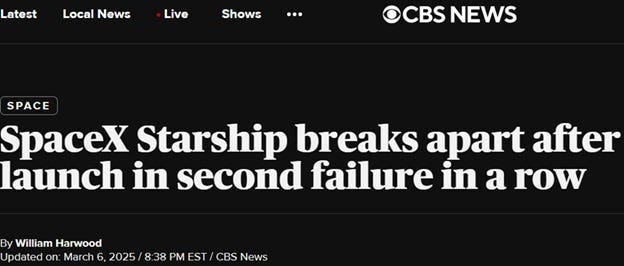The American Dream of SpaceX
We are up to eight Starship rocket launches now. A few launches ago we saw the Mechazilla catch the 400-foot Super Heavy booster rocket for the first time, an amazing accomplishment that humanity has never experienced or even gotten close to achieving before. And the second catch happened just last week. We were able to see a first-of-its-kind spaceship accomplish amazing things. While watching the livestream of any of these launches, one could see the whole SpaceX team involved with the project eagerly celebrating the various phases and stages. Emotions were running high as the excitement, dedication, and overall curiosity and sense of accomplishment of this groups was palpable—even through the TV or computer screen.
Recently SpaceX also rescued two astronauts who had been stranded aboard the International Space Station for 280 days. The views we were looking at for the launches were brought by Starlink, which is the internet platform of SpaceX, another innovation.
Watching the recent achievements of Starship is always an amazing feeling. We’re seeing progress and technological evolution happen right before our eyes. Every test is designed to improve on something that didn’t work before. Even if we won’t experience multiplanetary living or going to Mars just yet, these steps still represent amazing feats of human engineering and intelligence that are steppingstones for future space missions and overall societal progress. What humans have been able to accomplish is truly inspiring.
I won’t delve into the details of what is happening with the Starship test flights, Starlink launches, and everything they have been working on. After all, that is actual rocket science, and as an economist I know nothing about it. (Although I wouldn’t be surprised if other economists think they know more than Musk or the SpaceX team does about their own field.)
But what I do want to comment on are the social and cultural influences that underlie the narrative of pessimism and doomerism that spans the world. In most of the launches so far, critics and haters—for lack of a better term—have jumped on the opportunity to point out any little thing that went wrong. Very few people in the cultural industrial complex pointed out the amazing feats that this team is accomplishing—not only for their own sake but for the sake of humankind. There are many complicated issues and details to resolve, and the only way to figure things out is through the scientific process of observation, experimentation, and analysis that the SpaceX team is doing.
So what critics are highlighting as “failures” are actually expected steps in the millennia-old system of trial and error that humans have engaged in to develop and grow as a species. Maybe, as with the case of the American Dream, the critics are just overly pessimistic and enjoy pointing out others’ supposed “mistakes.”
Here are some of the latest examples and headlines of this negative attitude:
There is a lot of unfavorable coverage around every new attempt at advancement. In 1880, Henry Morton, president of the Stevens Institute of Technology, confidently asserted, “Everyone acquainted with the subject will recognize it as a conspicuous failure.” He was talking about Thomas Edison’s light bulb. In 1949, mathematician and physicist John Von Neumann, fully convinced that his opinion was fact, stated, “We have reached the limits of what is possible with computers.”
Lest anyone get the wrong idea, this is not a defense of Elon Musk the man, SpaceX the company, or of businesses as a whole—although I wouldn’t have a problem writing about any of those. There are a great many things that could be written—despite some negatives—since no one/no company is perfect. Katherine Boyle at the Free Press had a fascinating piece discussing the impact SpaceX is having on space travel, American dynamism, and humanity. The recent Musk biography by Walter Issacson provides a deeper and more nuanced take on the man behind the rockets. And there’s plenty to say about businesses as a whole being a force for good.
But most importantly, the recent rocket-catching success is a defense of the American Dream and the innate human capacity for innovation, ingenuity, and dynamism. These characteristics need to continue being part of, and actually a cornerstone of, the cultural fabric of the United States.
Which is why when we focus primarily on security instead of dynamism, we are going down the wrong path. When we focus on degrowth instead of accelerating growth that can lift people out of poverty and enable more human flourishing, we are going down the wrong path. And when we lack the perspective of excitement and awe at what these great achievements mean for the future of humanity and try to discourage them, we’re on the wrong path.
What SpaceX and others are doing in terms of space flight is just the beginning. Their accomplishments need to be lauded and recognized with pride, optimism, and hope for the future. Achievement and success shouldn’t be frowned upon in our society; they should be celebrated not only for the sake of the many team members of SpaceX who are achieving amazing things but also for the sake of current and future generations who dare to have their own dreams but need some inspiration to start on their own paths—their own paths of living the dream.
Musk’s American Dream with Space X seems to be what he has asserted since founding Space X, making humans a multiplanetary species. I’m sure that if you asked SpaceX employees and board members what their American Dream was, we would get fascinating answers. Boyle sums it up nicely: “SpaceX is the company of return. The return of boosters. Spacecraft. Ambition. Greatness. And the days of when rocket scientists and janitors alike believe they are helping to put men on Mars, awakening the next American Century.”






